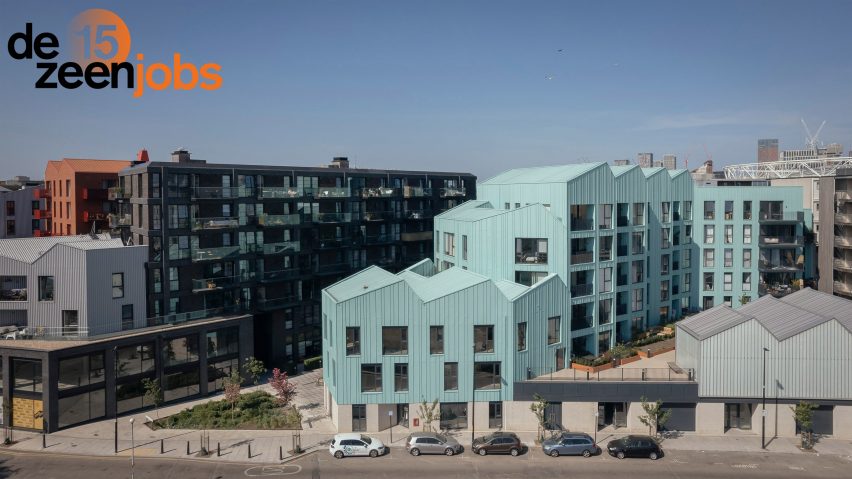As part of our Dezeen Jobs: How We Recruit series, architecture studio dRMM's director Saskia Lencer explains what the practice looks for when it hires new staff and how its recruitment needs have changed over the years.
Anna Marks: Please can you talk me through dRMM's past and current projects?
Saskia Lencer: We've been involved in a large variety of projects, from very small interventions to town centre regenerations. We've built great schools and have worked on hotels, workspaces, large-scale mixed-use residential-led schemes, as well as infrastructure and cultural projects.
Our projects are linked in that they have the ambition to support sustainable communities – that's the driver behind all of them. dRMM just completed WorkStack, a multi-storey building primarily constructed in cross-laminated timber (CLT).
We're also waiting for the final tenant to move into Wick Lane, a mixed-use project that combines homes, workspaces and industrial users in Hackney Wick. In addition, we're working on the Tustin Estate, which is a regeneration project for Southwark in London, as well as other large-scale mixed-use projects.
A lot of community engagement is involved in our projects and that's getting more important, and now also supported by clients. We're also working on a Passivhaus scheme in Exeter and some externally funded research projects.
Anna Marks: Where do you currently stand on recruitment in comparison to 10 years ago?
Saskia Lencer: dRMM has been growing constantly in the last 10 years. It has always been a very strong diverse team with collaborative individuals and it hasn't changed in that regard. We try to recruit from within the team as much as we can and let individuals find their roles within dRMM.
The one change in the process itself is that the application process is now mainly virtual – we do our first interviews virtually rather than in-person. However, I think it is always important to see the applicant in person before hiring. Virtual interviews have allowed us to attract younger individuals from further away so they can do the interview abroad and it has helped in that regard.
Anna Marks: Has your interview process changed?
Saskia Lencer: Diversity has always been on our agenda but we have concentrated on it even more recently. We're much more aware of minimising unconscious bias in our recruitment process. All our team members who are involved in interviewing responsibilities attend unconscious bias training.
Whenever possible, we have a 50/50 gender balance in terms of interview attendance. Having said that, we've always been at least 50/50 in terms of gender balance within the team. It has always been part of us but we're much more aware of it than we were in the past.
Anna Marks: Are there any new skill sets you require?
Saskia Lencer: The team members at dRMM have to be really well-rounded in Revit. We also need the team or the individual to be able to work in a hybrid mode – to work from the office or at home.
Having outspoken team members has always been very important to dRMM so that they communicate their wishes and thoughts.
The most important thing for us is that the individual fits into our studio. It is about the individual and for them to understand our ethos – who we are – and about collaboration.
Anna Marks: What catches your eye when looking at an application?
Saskia Lencer: Personally, anything that is not necessarily traditional. If the applicant has been abroad that's one of the things that catches my eye instantly.
If they also have had experience on-site or have actually had experience building their own projects, that is something that is a very useful skill because they have technical knowledge already, but 'making' actually isn't the most important thing.
One of the most important things is really understanding how materials work, how they come together, and how they can be used. This sets the candidate on the right path to understanding how we work.
Anna Marks: Has AI had an impact on your recruitment process?
Saskia Lencer: We've been through a very large recruitment process recently and I've seen a lot of cover letters where AI has been used. Cover letters have become much more streamlined but you can always find certain wording and phrases that are now repeated throughout.
I don't necessarily see an issue with it, as long as it shows a true understanding of our studio and the role, and conveys the personality of the applicants.
Anna Marks: What advice would you give people who wish to join dRMM?
Saskia Lencer: It is always good to understand why the candidate has decided to apply and wants to work for us. They should be clear and communicate their interests and ideas.
Anna Marks: How has Dezeen Jobs helped build your company?
Saskia Lencer: Dezeen Jobs is providing us with a very good balance of interesting people from all over the world. I think it's one of the few sites where we actually find that.
Dezeen Jobs: How We Recruit series
This article is part of Dezeen Jobs: How We Recruit, a series of interviews to mark Dezeen Jobs turning 15, which explores changing hiring practices and future recruitment needs for companies around the world.

